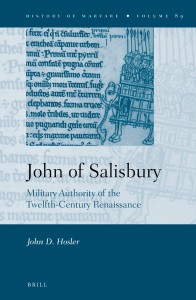John Hosler
John of Salisbury: Military Authority of the Twelfth-Century Renaissance
(Brill, 2013) 227pp. $133.00.

In John of Salisbury: Military Authority of the Twelfth-Century Renaissance John Hosler seeks to raise Salisbury’s profile among historians of the High Middle Ages, and especially those interested in medieval warfare. His book succeeds in demonstrating Salisbury’s interest in medieval warfare, and he shows convincingly that Salisbury should be studied as more than a political theorist, but also as an observer and commentator on twelfth century warfare.
Hosler organizes his book thematically around examinations of Salisbury’s language, coverage of soldiers, logistics, battle and campaigns, the language of warfare, and a detailing of Salisbury’s value as a historian of contemporary wars (as opposed to a commentator on warfare in general). This allows Hosler to approach Salisbury comprehensively as a military authority, and to craft a holistic picture of how Salisbury saw warfare, and how he fit warfare into his broader understanding of the society around him.
His examination of Salisbury’s military lexicon (Chapter 1) seeks to identify and catalogue every time Salisbury used a military term, and to offer an analysis of any potential patterns in his usage with the intent of understanding what he actually meant by terms that could have multiple meanings at the time (such as the oft-debated miles/milites). Salisbury’s use of language is especially important regarding his importance for the development of chivalry. Holser argues that modern historians have been incorrect when using Salisbury to define an idealized chivalric model, since Salisbury only sought to create an idealized image of a Christian knight, rather than a chivalric knight (Holser points out that none of the 82 uses of miles in the Policraticus refers to a stereotypical medieval knight). While Hosler’s point is well-taken, the importance that contemporaries placed on an idealized image piety necessarily fitting within an idealized chivalric ethos indicates that the division that Hosler seeks to make may be more semantic than reflective of Salisbury’s ideology. Overall, however, the first chapter represents a nuts-and-bolts look at the language of Salisbury, which, while it does not always make for the most exciting reading (though Hosler handles it with humor and style), it is a necessary precondition for analyzing Salisbury’s ideas on warfare.
The middle chapters of the book, covering soldiers, armies, and logistics, give the clearest insights into Salisbury’s ideology, and thus command the most in-depth coverage and analysis from Hosler. What becomes evident is that Salisbury was consistently approaching the “How to wage war” question from the perspective of Classical exemplars. For instance, he argued that soldiers had to be properly recruited and “sworn” to service, and he relied on examples from Vegetius and the Old Testament (with a complaint about the laziness of contemporary English soldiers thrown in) for support, but he also readily admitted that the military oath as understood by the Romans was not often used in modern England. There are similar discussions and disconnects between the ideal Roman approach and the existing medieval approach to warfare in regards to the paying of soldiers and the use of militias, and in each case Salisbury interwove Classical and Biblical examples to support his vision for an ideal military based on Rome. Throughout these chapters, Salisbury compared the “soldiers” of his day with those of Rome, but it is not clear whether Salisbury addressed the basic vocational differences between those who fought in an organized military in Rome, versus those fighting in his own day. Presumably Salisbury was aware of this, and thus his work is prescriptive in the sense of pushing twelfth century warfare to more resemble Classical, but while Hosler discusses this issue at the end of chapter 2, additional illumination of it would have been helpful.
As an observer of contemporary warfare, Salisbury was an uneven source. Hosler does an admirable job of demonstrating which campaigns John should be seen as a valuable source for (such as the Second Crusade, Barbarossa’s Italian campaign, the siege of Damascus, and the Rheims rebellion of 1167), and those that he does not add much to in our understanding, such as his discussions of Henry II’s campaigns in Wales and Poitou.
Overall, Hosler paints a compelling image of Salisbury as an important source for our understanding of twelfth century warfare, despite his having never been a soldier (nor present at battles himself). Salisbury saw warfare as at the center of medieval society and thus it suffused his understanding of a whole host of social and spiritual issues. Hosler shows that Salisbury’s use and reliance on Classical models to try to chart a better path forward for medieval society fits him into the broader discussion of the “twelfth-century Renaissance”.
Craig M Nakashian, Ph.D.
Texas A&M University-Texarkana
[email protected]
